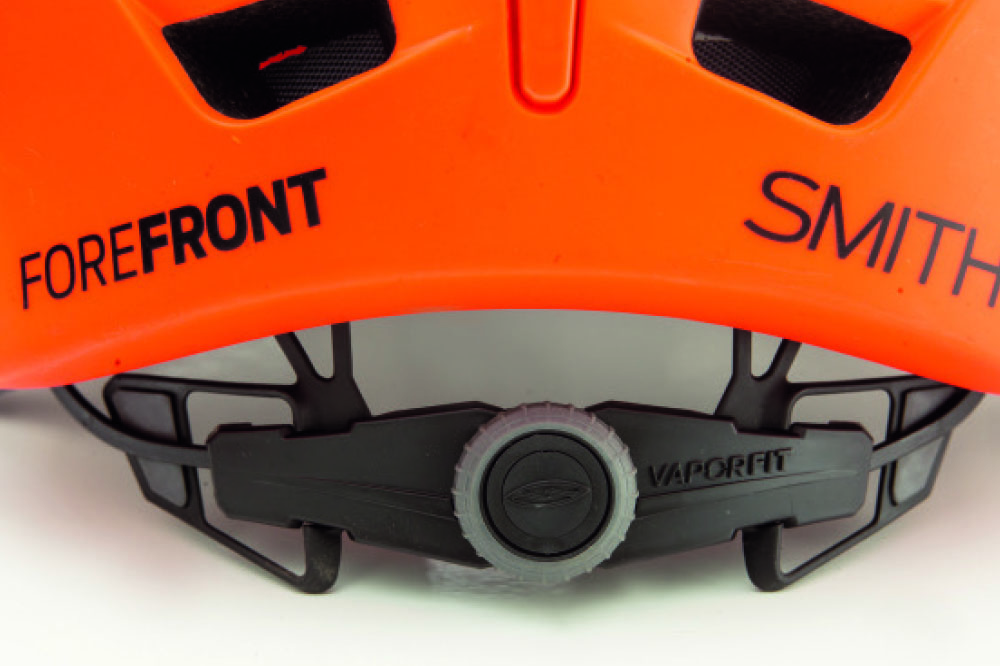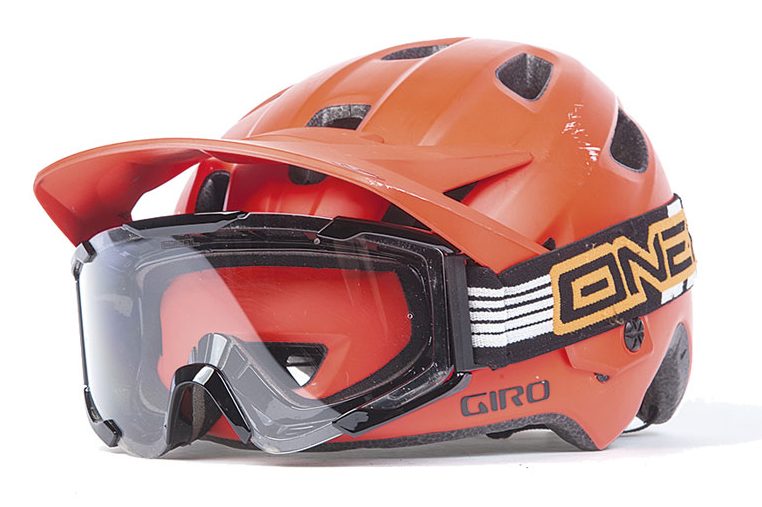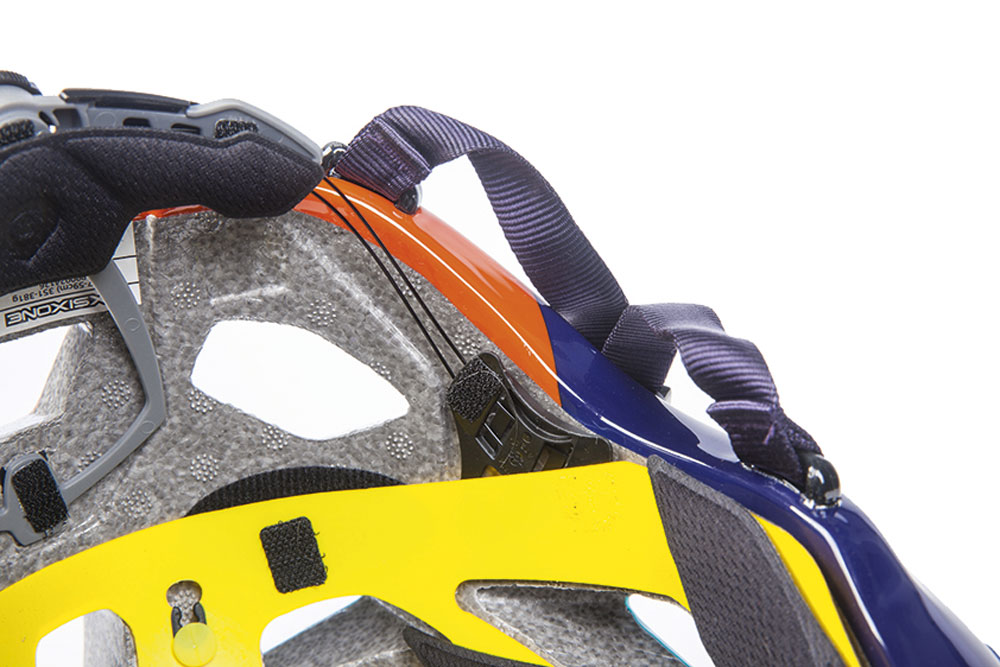Products You May Like
The best mountain bike helmets are primarily protection but they can also be stylish and comfy things to wear in their own right. Here are a dozen favourites at various price points.
First things first, this guide is for regular open-face helmets, suitable for most trail and cross-country riding. If you’re looking for full-face or convertible lid for bike park riding or gravity use, then check our our guide to the best mountain bike full face helmets.
How we test the best mountain bike helmets
All mountain bike helmets pass the current CE test so we’re taken it as read that they’ll work if you clonk your head on a passing tree. However, there’s currently no test for fit, venting or adjustability, which is why we’ve focused on these things when testing. To test the fit, we measured the shape of each one but that doesn’t reveal any hot spots, which is why we did lots of in-field testing, to test the true comfort. Riding hard we could also gauge the breathability and venting of the helmets.
‘View Deal’ links
You will notice that beneath each of the best mountain bike helmets product summary is a ‘View Deal’ link. If you click on one of these links then mbr may receive a small amount of money from the retailer should you go to purchase the product from them. Don’t worry, this does not affect the amount you pay.

Does everything as top-end helmets whilst costing less
Weight: 426g | Sizes: S, M, L | Rating: 10/10
Pros: Even more of a bargain Cons: Can run on the warm side
The best just got cheaper. Yes, Bell’s convertible Super 3 enjoyed a £20 price drop in recent years, making it even more of a bargain. It’s still a great fit thanks to the Float Fit retention system and it offers a decent amount of ventilation considering the amount of protection on offer. There’s a wide peak that swings up far enough to let you stash a set of goggles underneath and the whole construction feels solid and durable. Its real party trick, however, is the optional chinbar, available for an extra £80. Invest in that and you’ve got two helmets in one, making it the perfect companion for a day in the bike park. The Bell Super 3 is the best trail helmet because it strikes the right balance between durability and venting. It’s weighty and the lower edge where the EPS is left exposed is starting to look tatty but its cracking value for money and the chin bar compatibility lifts it to a whole different level.
Read our full test review of the Bell Super 3 helmet

Giro Tyrant
Extra peace of mind without cooking your brain
Weight: 623g | Colours: Yellow, blue, black | Sizes: S, M, L | Rating: 10/10
Pros: Great for when full-face is too hot Cons: There’s a weight penalty
This quirky looking lid is being worn by 50:01’s very own Ratboy in the marketing shots. So does that mean it’s irrelevant for the rest of us? Riders who prefer to ride a loop on a Sunday instead of finding twenty different ways to slide along a log? Not in our opinion. Resembling a motorcycle trials helmet, the new Giro Tyrant adds a bit more protection to the enduro half-shell, placing it somewhere between an open face and a full face. The outer hardshell is really durable, while inside there’s MIPS’ new Spherical liner, where the whole inner section of foam can rotate in the event of an angular impact. Dual density foam further helps with impact absorption, but even with all that extra coverage, there’s enough airflow to keep you comfortable on a summer’s day.
Read our full test review of the Giro Tyrant helmet

Oakley DRT5
One of the most comfortable helmets we’ve experienced
Weight: 440g | Colours: White, blue/black, grey, green | Rating: 10/10
Pros: Excellent for hot heads Cons: More expensive than Bell Super 3
One of the most famous brands in sunglasses has branched out into the helmet market with the Greg Minnaar signature DRT5, and for a first attempt, it’s seriously impressive. The BOA retention system, in combination with the MIPS liner, is luxuriously comfortable, while a silicone sweat gutter up front keeps drips out of your eyes. There’s also a clever set of clamps at the back of the helmet that’ll securely hold your sunglasses when you don’t need them, even if they don’t have a squashed O on the arms. At 440g the Drt5 is on the heavy side, but comparable with favourites like the Bell Super 3, and its secure hold on your head means it’s not really noticeable when riding. It’s also slightly more money than top end lids like the Giro Montaro or Endura MT500. But it’s a step up in quality from both of those, the finish is brilliant, and the extra features that could be so gimmicky are actually astute and desirable.
Read our full test review of the Oakley DRT5 helmet

Fox Speedframe Pro
Well thought out, comfortable and protective
Weight: 437g | Sizes: S, M, L | Rating: 10/10
Pro: Form, function and a fair price
Con: Liner moves around a little
A new kid on the block, but it has MIPS and a dual-density EPS, it also fits great and feels comfortable. It also looks way better than any previous Fox helmet we’ve tested, and while that shouldn’t matter, somehow it does. Offers a a ton of protection and have all the goggle-parking, camera-wearing, visor-tilting features you’ll ever need. Launched relatively recently, the Speedframe Pro went straight to the top of our helmet rankings when we tested it. Dual density foam is employed throughout, ensuring the Speedframe is as effective as possible in both high and low speed impacts, while the MIPS liner further helps dissipate rotational forces. Fox has ensured ample venting too, and the visor tilts right up if you want to stash goggles underneath. Finally, clever features such as the quick-lock magnetic strap closure help elevate the Speedframe Pro above its rivals.
Read our full test review of Fox Speedframe Pro helmet

Bell Sixer MIPS
A great helmet at a great price
Weight: 392g | Colours: White, grey, green, blue, Fasthouse | Sizes: S, M, L | Rating: 10/10
Pros: Great alternative if you’re not a fan of the Bell Super’s aesthetic Cons: Very very slightly fiddly vertical retention adjustment
Always at the forefront of helmet tech, Bell’s Sixer brims full of tech and provides a superlatively comfortable fit. Varying densities of foam are used to build up the structure of the Sixer, each one optimised to absorb different impact velocities. The visor tilts up in stages sufficiently to stash goggles beneath, and there’s a rubber strap grip at the back. We love the Float Fix Race retention device, which is highly adjustable with no pinch points, and your riding buddies will love the X-Static pads that help prevent funky smells building up on hot days. A great looking helmet at a great price. In terms of features and detail, the Sixer is step up from the Super 3. It’s comfortable and looks sleeker. A great helmet, at a great price, test winner in the all-rounder trail riding category.
Read our full test review of Bell Sixer MIPS

Troy Lee Designs A3 helmet
Comfort and style rolled into one
Weight: 411g | Sizes: XS/S, M/L, XL/XXL | Rating: 9/10
Pros: Stunning looks and superb comfort Cons: You’ll need deep pockets
Troy Lee Designs’ third generation trail lid is its best yet, delivering the desirable styling so coveted by its fans with brilliant function and comfort. Superb fit, thanks to a full 360º retention system that perfectly cradles every head shape we’ve thrown at it, ensures stability in the rowdiest terrain while remaining impressively discreet. There’s enough ventilation for most summer temperatures and clever tech, such as the magnetic peak and chin buckle, helps raise its performance above other high end rivals. You also get a spare set of pads, sweat brow pad and a helmet bag to help make the high price tag more palatable.
Read our full test review of the Troy Lee Designs A3 helmet

Takes impact protection to the next level
Weight: 348g | Sizes: S-M, M-L, L-XL | Rating: 9/10
Pro: Ticks all the important boxes
Con: Not quite as finely finished as rivals
The MT500 is packed to the gills with features, including an adjustable peak, anti-bacterial padding, eyewear dock as well as a clip-off accessory mount for a headlight or helmet-cam. The peak lifts far enough up to store goggles and the straps are held securely under the peak edges and a large (removable) clip at the back. Underneath the slightly dour looks there’s a cracking trail helmet, we just wish Endura would add a bit of bling to the skin. We found the MT500 to be a little short front-to-back but it’s standard width and feels really comfortable even with the dial snugged up tight. When it comes to construction and details, it ticks all the boxes.
Read our full test review of the Endura MT500 helmet

Smith Engage MIPS helmet
A top quality helmet at a mid-range price
Weight: 344g | Colours: Orange, White, Black | Sizes: S, M, L, XL | Rating: 9/10
Pros: Excellent stability, comfort and styling Cons: Ventilation could be better
We’ve always liked Smith’s range of sensibly designed, uniquely styled helmets, and the Engage brings these qualities to a lower price point. You still get the MIPS liner, designed to reduce injuries from rotational impacts, and snug, secure, 360º retention system with dial adjustment. It doesn’t boast quite the same level of venting as more expensive Smith helmets – the more basic construction means more material is needed – but it’s still cool enough for most riders and most temperatures.
Read our full test review of Smith Engage MIPS helmet
Key features of the best mountain bike helmets:
The best mountain bike helmets sit a bit deeper on your head, extending down the nape of the neck, and they have extra coverage around the temples. Lots of helmets now incorporate some kind of rotational proection device, such as a MIPs liner, to reduce the risk of concussion. This can also be in the form of integrated reinforcement or crumple technology. There’s normally a visor, or peak, that you’ll be able to adjust up and down, and you may even see features such as integrated adapters to mount a POV cam or light, magnetic buckle closures, goggle strap clips and a storage bag.

Indexed visor adjustment
Any bike helmet will work off-road but if you’re reading this, chances are you’re a trail warrior and you’ll want something a little bit more specific. A modern trail helmet will sit a bit deeper on your head and have extra meat over the temples and down the back, for greater protection. It’s likely to have some sort of built-in rotational device like a MIPs liner, to reduce the risk of concussion or some integrated reinforcement or crumple technology. You’ll get a visor that you’ll be able to adjust it up and down and you may even see integrated adapters to mount a head cam or light, magnetic closures, goggle strap clips and a storage bag.
Fully loaded, a good trail helmet isn’t going to be cheap but we believe it’s a small price to pay for something that could save your life.
Due to the trickle-down effect you will see some high-end features included on budget helmets but we’ve focused on the top-tier simply because that’s where there’s the greatest choice. These helmets are more refined, harder wearing and look pretty sick too.
How to find your helmet size
Get hold of a fabric or paper tape measure if possible. If you don’t have one, don’t try and wrap a metal tape measure around your noggin, it doesn’t work – believe us. In the absence of a fabric/paper tape measure, find some string and wrap that around your head and note its length.
Whereabouts to measure around your head? Essentially around the widest (biggest circumference) part of your head. Around your forehead and around the most prominent bit of the back of your head. Note down the measurement in centimetres. All helmets have size ranges and with your head measured it’s then easy enough to find which sizing has your head size covered.
How often should you replace a helmet?
You should replace a helmet after any slightly significant impact or crash. A lot of helmet companies offer crash replacement schemes so it’s worth checking out their websites for info about such things.
In terms of general lifespan, it’s typically advised that you should think about replacing your helmet every two to three years. Some companies in the past have stated a longer term than this but we’d feel a bit iffy using a helmet that’s had more than three years proper trail riding use. General wear and tear as well as things like UV degradation can have negative affects on the performance and reliability of your helmet.
Best mountain bike helmets protection standards
All bike helmets sold in the UK need certification. This means helmets must meet certain fixed test criteria like impact velocities, roll-off tests, and strap system strengths. This is a minimum and many modern helmets surpass these requirements by incorporating composite materials into sub frames or “roll cages” for extra protection.
Crash replacement schemes
If your helmet is involved in an accident, most manufacturers offer a reduced price crash replacement scheme. With proof of original purchase, these programmes can save you up to 50% on an expensive replacement lid.
EPS
EPS (expanded polystyrene) foam is at the core of every bike helmet and works exactly like a crumple zone in a car. Modern helmets use different densities and some are even reinforced with an internal mesh or webbing.
MIPS
Multi-directional Impact Protection System is a patented protective liner that slides when your head hits the ground, reducing the force of them impact and likelihood of a concussion or brain injury. MIPs is a branded product so several manufacturers do their own version usually with an equally ambiguous abbreviation.

The inside of a Koroyd-equipped helmet
Padding
Padding thickness and density has a significant effect on sweat absorption, cooling and comfort. Thicker internal padding may run a little hotter but you’re less likely to get sweat running down your neck and the helmet will generally feel more comfortable. Channels are often formed into padding to improve air flow and speed up drying.

Retention band
Retention device
Like in a baseball cap, a retention device allows you to adjust the fit of the helmet. Most use a dial, which allows you to tune the tension/size with one hand while riding. You can also adjust the height using press-studs or a sliding clip.

The less exposed polystyrene the better
Shell
To reduce dings and dents, the EPS it’s covered with a thin plastic micro-shell. This is usually in-moulded with the foam during the manufacturing process and can be one or several pieces.
Ventilation
Vents at the front of the helmet allow air to flow in and those at the back let it flow out again. Generally, the more the merrier but the shape and angle of the vents and how they integrate with the peak is key to keeping cool.

Some peaks are bigger than others
Visor/Peak
Being able to tilt the visor up means it doesn’t block your vision when riding with you head down but it also allows you to ‘park’ your goggles underneath. To hold the goggle strap securely, most helmets have a channel called a strap-gutter round the back but we also see clips or small tethers.

If you wear goggles sometimes, it’s good to check the lid will accommodate them properly
Goggle parking/strap gutter
On some helmets the visor can be tilted up so you can ‘park’ goggles underneath when you’re not using them. Usually this feature comes hand in hand with a strap gutter – a shallow channel on the back of the helmet that holds the strap in place.

The signature yellow MIPS slip-liner
Bottom wrapping
To add extra protection to the lower edge of the EPS the micro-shell often wraps under the bottom of the helmet.
Sizing
Helmets come in various sizes. Small, medium and large is pretty standard but you also see overlapping sizes like S/M and M/L. One company’s medium can also be another’s large and some helmets are long and thin, while others are short and squat. All of which means there’s no consistency in sizing or fit and you should always try before buying.
